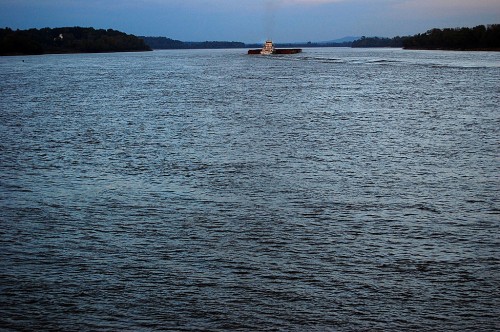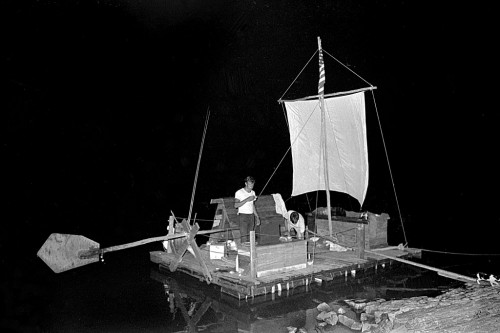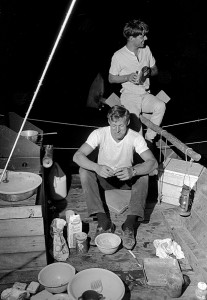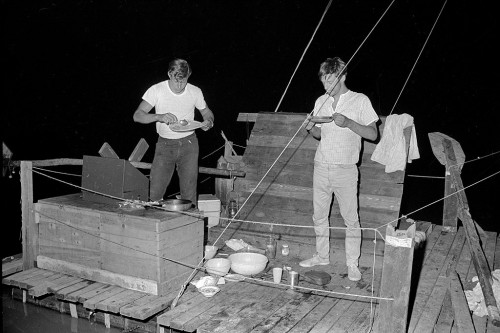 The Mississippi River that boiled past Cape Girardeau in the 1960s wasn’t a waterway for skiing and other recreations pursuits. Sewage treatment upstream was minimal in the days when the solution to pollution was dilution.
The Mississippi River that boiled past Cape Girardeau in the 1960s wasn’t a waterway for skiing and other recreations pursuits. Sewage treatment upstream was minimal in the days when the solution to pollution was dilution.
The first time a water skiier saw the unspeakable goop that was splashed up on the sides of of his ski boat was probably the last time he dipped himself into the ooze.
Our Mississippi was a working river
No, our Mississippi was a working man’s river, full of massive tows of coal, grain and concrete going to build and feed this great land.
It was also a challenge to the adventuresome.
Adventure on the Mississippi
 It was my phone that would ring early in the morning or late at night when someone spotted a raft, an innertube, a kayak or a canoe pulling into the wharf. Since I was a two-fer – a combination reporter/photgrapher – it meant that two people didn’t have to head down to the river.
It was my phone that would ring early in the morning or late at night when someone spotted a raft, an innertube, a kayak or a canoe pulling into the wharf. Since I was a two-fer – a combination reporter/photgrapher – it meant that two people didn’t have to head down to the river.
I couldn’t find The Missourian story about these two guys pausing at Cape on their journey south. I know I did a story, but I don’t know when it ran, and Google Archives didn’t have it indexed. I used every search term I could think of: raft, rafters, Huck Finn, Tom Sawyer, journey, adventure…. and came up blank.
Two college girls happy to abandon quest
I DID find a story about Miss Marrianne Ahrne, 21, of Falkoping, Sweden, and Miss Betty Kozak, 19, of Downwers Grove, IL, in the June 17, 1961, Missourian.
 They started out from St. Louis headed to Cape, but were turned back by the Coast Guard because they were using a flimsy plastic raft. The next day, they hit the river with a more substantial rubber raft, two cans of beans, two cans of spaghetti, blankets, blue jeans and bathing suits, “contemplating an idyllic float on the Mississippi River, golden brown sun tans and the good life.”
They started out from St. Louis headed to Cape, but were turned back by the Coast Guard because they were using a flimsy plastic raft. The next day, they hit the river with a more substantial rubber raft, two cans of beans, two cans of spaghetti, blankets, blue jeans and bathing suits, “contemplating an idyllic float on the Mississippi River, golden brown sun tans and the good life.”
It wasn’t long before they hit a storm that almost swamped them. They were rescued by a northbound towboat, which handed them off to the southbound Motor Vessel Illinois, which took them as far as Chester.
Cold, miserable and bug-bit
Another storm stranded them on a sandbar where they were spent the night soaking wet and covered with mosquitoes. They decided to wade through ankle-deep mud to see if they could find help. Unfortunately, they saw no sign of life at the only building they came to.
The next morning, scratched, bruised and covered with mosquito bites, they made it down near Wittenburg, where a farmer gave them a ride to Cape. They cleaned up at the St. Charles Hotel, shipped their baggage by rail and abandoned their river adventure.
Did they make it to New Orleans?
 These guys seemed a little better prepared than the hapless Misses Ahrne and Kozak. I wonder if they made it all the way to the Gulf of Mexico. I also wonder how many cub reporters interviewed them along the way.
These guys seemed a little better prepared than the hapless Misses Ahrne and Kozak. I wonder if they made it all the way to the Gulf of Mexico. I also wonder how many cub reporters interviewed them along the way.

Ken, I seem to remember seeing a news story on these two guys. It seems like it was after we moved to Florida in 1964. Of course, it could be just my imagination.
Margi,
I know the story ran. I just can’t find it. Google News Archive, which has old newspaper microfilm files on line, reminds me of the little girl described by Henry Wadsworth Longfellow:
“…when she was good,
She was very, very good
But when she was bad she was horrid.”
Their Optical Character Recognition indexing can either be right on or it can be totally off the mark. That makes for some interesting diversions sometimes, but it’s also very frustrating.
To make it worse, Google will sometimes combine several days at a time, which also throws off the indexes.
I’m in a chicken-and-egg quandary: do I look through all my negs so I’m familiar with them and then go through the archives a day at the time, or do I go through the archives first so I can be looking for the photos?
I’m doing a combination of that now. I look through the film, look up the story and also make notes about stories that I want to come back to.
Sometime I should post some of my own photos of the time in early spring 1969 when four of us tried to do a trip down the Mississippi. But it was in canoes, not a raft. And it was a lot further north than Cape Girardeau, and there had been a very cold spell the week before. And we knew we didn’t have time to make it as far as Cape Girardeau even if things went smoothly, which they didn’t. No news photographers came to see us, but in Little Falls a fur trapper asked what we were doing, and then said, “Boys, come with me. There’s something I want to show you.” That was the end of the adventure.
But speaking of adventures, I’m wondering if Cape Girardeau is planning to celebrate the 200th anniversary of the time when the river flowed backwards.
John,
You’re referring to the New Madrid Earthquake of 1811-12, of course.
I wrote about the New Madrid Earthquake on my bike blog.
Here’s an interesting tour through the New Madrid seismic zone that I just found.
My brother, Mark, had a teepee that he used for Order of the Arrow camping. A buddy of his borrowed it to go to Alaska or somewhere for a trapping expedition.
The poles are still lashed to a tree in my Mother’s yard. (She keeps threatening to use them for firewood, but it hasn’t happened in the last 35 or so years, so they’re probably safe.)
Ken,
You don’t seem to have a link to your bike blog anywhere on this one, including in the above comment. I hope it’s not in some kind of internet witness protection program. But I managed to find it and the New Madrid article, anyway.
The article you linked above has got me thinking about a bike ride to the area to see it, and also to fill out my set of rides to Tecumseh-related places. Not saying I’m going to — it’s just one of those ideas that sometimes pop into my head.
Thanks, John, for letting me know about that. I made a typo in the URL.
If you make it down to Cape, be sure to let the Convention Bureau people know that you made the trip because of what you read here. I’ve been trying to convince them that this site brings people into their community.
The Tipi you referred to was 12 feet in diameter. Slept four when you had a fire in the middle and more in the summer when you didn’t have a fire. Cedar poles that I cut and debarked were 16 feet long and the lifting pole was 20 feet long. I could set the tipi up by myself in about a half hour, but getting the poles around was a real chore. Used a 1977 Datsun King Cab pickup truck that was fitted with a special pole carrier support on the back of the truck and roof racks to help distribute the rest of the weight of the poles on the top of the truck.
Randy Farrar borrowed the tipi one winter and headed up to Minnesota to trap beaver and muskrat for the state to keep the population in control. He spent the entire winter up there living in that tipi. He took a pot belly stove and used that for heat and cooking inside the tipi. He was planted way out in the sticks and he used to say that the locals would load up the kids in their cars on Sunday and seek his campsite out. They would drive by and see all the furs and his campsite and his long hair and beard and tell the kids he was the last of the real fur trappers. He returned the tipi to me after his trip and I used it once or twice and then it went into storage. I have two sets of poles for the tipi, one at the house and one set in Dutchtown, MO. I know that my mother eyes those tipi poles every winter when her fireplace wood supple gets low….
You are indeed correct about skiing on the river. I and a few intrepid (read: stupid) friends from the class of ’68 decided on sunny Autumn afternoon in 1967 I believe that we would ski the river. And we did. I remember the first time I fell after hitting a log, a body or perhaps an eight-foot alligator gar. The Mississippi runs much faster than its languid look, even that time of year. I was really beginning to wonder if Gene Feuerhahn would get back to retrieve me. He did, but just as a nice moldy sofa floated past. My system developed a new range of antibodies after that episode. If asked to do it again, I would invoke the words of the late Samuel Goldwyn of MGM fame: “Include me out.”
Did this in 1967…gave up in Memphis…book coming called BIG MUDDY. Our raft looked very much like this square sail one..from Rocheport, Mo…on the Missouri River to Memphis,TN..we stopped short of our New Orleans goal..BIG ADVENTURE..check out BIG MUDDY when it is published.